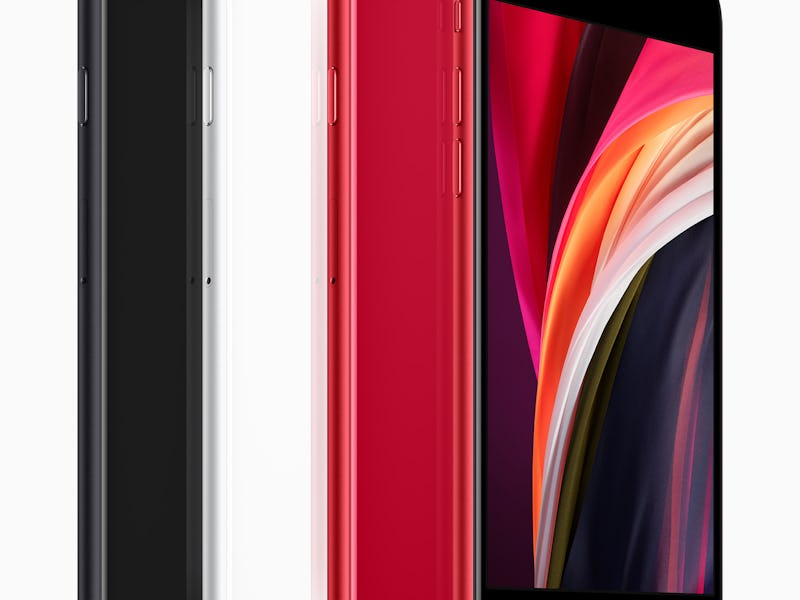iPhone SE: how increasing lifespan make it a great fit for the 2020 buyer
Apple's new smartphone is an ideal fit for the budget-conscious consumer.

Apple launched its second-generation iPhone SE Wednesday. The combination of a $399 price point and an A13 Bionic processor makes it ideal for value-conscious consumers keen to make their phones last longer than ever.
The new device replaces the iPhone 8 in Apple's lineup, and uses the same processor as the iPhone 11 flagship that launched in September 2019. It has a 4.7-inch screen with a Touch ID fingerprint sensor, just like the iPhone 8 it replaces. It has a single 12-megapixel camera with an f/1.8 aperture on the rear paired with a front-facing camera, both of which support Portrait mode to blur the background behind subjects. It's water-resistant, offers wireless charging and starts with 64GB of storage.
It could be the ideal time for a device like this. Consumers are holding onto their phones for longer than ever, with data from Kantar Worldpanel showing Americans hold onto phones for 22.7 months in 2016 but 24.7 months in 2018. Research from Yale University in 2018 found that consumers tend to hold onto iPhones for a year longer than Samsungs "even though the two brands are comparable in quality and technological innovation."
That may be due to better software support: the latest iOS update runs on the iPhone 6S from 2015, while Google only guarantees three years worth of updates for its Pixel phones. An iPhone SE buyer today could make their phone last for five years, the equivalent of $80 per year, while a $499 Google Pixel 4 could end up spending the equivalent of $167 per year over that three-year lifespan. Long-term performance is not always guaranteed, though: Apple was fined this year for secretly slowing down older phones where the battery couldn't maintain high processor speeds.
This could also be due to the fact that smartphone processors are incredibly fast. Unlike the early 2010s, there are few must-have software features on the way that are set to grind older phones down to a halt.
This is also the time when consumers will be increasingly concerned about their finances. The coronavirus lockdowns are expected to lead to a global economic recession, with the International Monetary Fund this week predicting a three percent contraction that ranks worse than the Great Depression. Goldman Sachs has forecasted a 15 percent unemployment rate in the United States, a figure it says "understates the severity of the situation," and a 35 percent decline in gross domestic product for the second quarter compared to the previous.
Even before these turbulent times, there were signs that many were unhappy with the high prices of phones. GlobalWebIndex found in 2019 that 28 percent of those with a smartphone that cost $600 or more thought their phone was too expensive.
The Apple iPhone SE
The iPhone SE could appeal to a consumer that needs a new phone, can't spend a lot of money, and needs to ensure it lasts a long time. The phone is the second-generation version of the original iPhone SE, which launched in March 2016. That device packed an A9 processor, the same as the then-flagship iPhone 7, into a design that bore strong similarities to the iPhone 5S. It had a four-inch screen, supported then-cutting-edge features like Apple Pay, and cost only $399. It's still supported by the latest iPhone software update.
The new model looks set to continue with that trend. It packs the latest features that only recently debuted on high-end iPhones, like Wifi 6 connectivity that will enable it to connect to the next generation of routers at high speed. It offers dual-SIM support through the internal eSIM, meaning it supports virtual SIM cards that make it ideal for traveling.
There are a couple of drawbacks that could cause it to show its age soon. It doesn't support 5G, just like all other iPhones, but it does support "gigabit-class LTE." It's also missing Apple's U1 ultra wideband chip, an addition to the iPhone 11 with limited use at this stage, but a chip that's expected to support Apple's tag system at a later stage. It also lacks face recognition, an OLED screen, the lidar scanner that's rumored to debut on the next iPhone, and it only has one rear camera. But when it comes to longevity, a fast processor could trump other factors.
For the consumer that wants cheap yet reliable, the SE could be the answer.